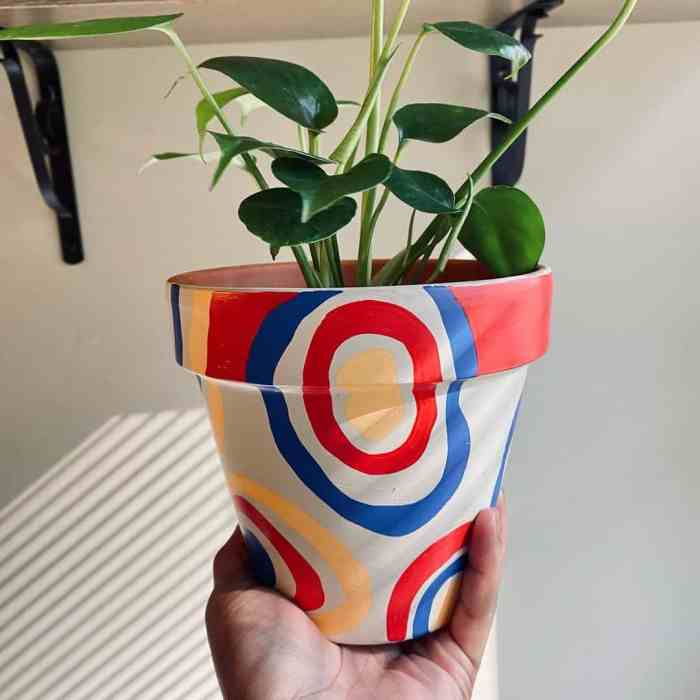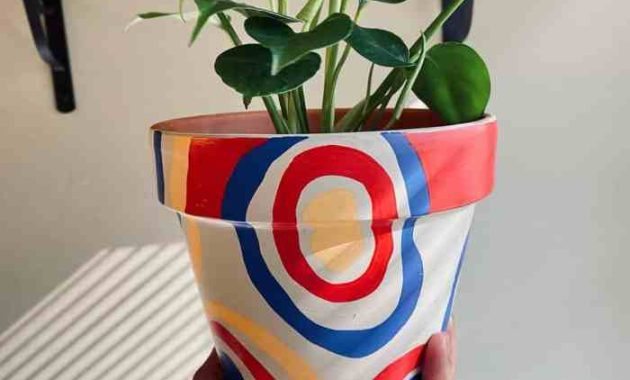Design Ideas and Inspiration for Painted Plant Pots

Paint a plant pot – Unleash your creativity and transform ordinary plant pots into unique works of art! Painting plant pots is a wonderfully therapeutic and rewarding activity, allowing you to personalize your home décor and add a touch of your individual style to your green companions. The possibilities are truly endless, limited only by your imagination.
Let’s explore some inspiring design ideas that will help you embark on your artistic journey. From bold and vibrant to subtle and sophisticated, there’s a perfect design waiting to be brought to life on your chosen pot.
Unique Design Ideas for Painted Plant Pots
The following ideas offer a starting point for your creative exploration. Remember, these are merely suggestions; feel free to mix and match elements, adapt them to your personal taste, and let your imagination run wild!
Revamping your plant pots? Painting them yourself is a super fun, budget-friendly way to add personality to your space. If you’re looking for inspiration, check out the unique designs available at hippie face plant pot amazon – they’re a great starting point for your own creative projects! Then, grab your brushes and unleash your inner artist to personalize those pots even further, adding your own flair to the already awesome designs.
- Geometric Patterns: Create a striking visual impact with clean lines and bold shapes. Think tessellations, stripes, or even intricate mandalas. A monochrome palette can create a minimalist aesthetic, while bright, contrasting colors add a pop of energy.
- Floral Designs: Embrace the beauty of nature with delicate blossoms, lush leaves, or vibrant wildflowers. You can paint realistic representations or opt for stylized interpretations, allowing for a greater degree of artistic license.
- Abstract Art: Let your emotions guide your brushstrokes. Experiment with textures, colors, and layering techniques to create a unique abstract masterpiece. This approach is perfect for expressing your individuality and capturing a feeling or mood.
- Nature Scenes: Bring the outdoors in with miniature landscapes. Paint serene forests, majestic mountains, or tranquil seascapes. Use varying shades of green, brown, and blue to create depth and realism.
- Minimalist Styles: Embrace simplicity with clean lines and a limited color palette. A single, bold color or a subtle gradient can create a sophisticated and understated look. This style allows the plant itself to be the focal point.
Earthy Tones Plant Pot Design
This design utilizes a palette inspired by nature, creating a calming and harmonious effect. The primary colors are terracotta, various shades of brown, muted greens, and creamy off-whites. The terracotta serves as the base color, mimicking the natural hue of unglazed clay pots. Different shades of brown are layered to create depth and texture, mimicking the look of tree bark or soil.
Muted greens are used to accentuate details, suggesting foliage or moss. Finally, creamy off-whites are used as highlights to create a sense of light and airiness. The overall effect is one of natural serenity, perfectly complementing the earthy tones of many houseplants.
Incorporating Textures into Plant Pot Designs
Adding texture elevates a painted plant pot from a simple design to a truly tactile experience. This adds another layer of visual and physical interest, enhancing the overall aesthetic appeal.
Textured paints offer a simple way to achieve this. These paints, often containing sand, grit, or other additives, provide a rough or bumpy surface. They can be used to create interesting patterns or to highlight specific areas of the design. Alternatively, you can add embellishments after the paint has dried. Small beads, glitter, or even pieces of broken pottery can be glued onto the surface, creating a unique three-dimensional effect.
Consider using different sized beads to create a textured pattern. For example, smaller beads could be used to create a subtle shimmer, while larger beads could add a more pronounced tactile element. The careful placement of these embellishments can significantly enhance the visual impact of your design.
Step-by-Step Guide to Painting a Plant Pot: Paint A Plant Pot

Transforming a humble terracotta pot into a vibrant work of art is a rewarding experience. This guide will walk you through the process of painting a plant pot, focusing on creating a charming floral design. With a little patience and creativity, you can achieve a professional-looking finish that will brighten any space. Let’s get started!
Preparing the Plant Pot
Before you unleash your inner artist, it’s crucial to prepare your plant pot for painting. This ensures the paint adheres properly and creates a long-lasting, beautiful finish. A well-prepared surface is the foundation of a successful project.
- Clean the pot thoroughly with warm soapy water and a sponge. Rinse well and allow it to dry completely. Any dust or debris will interfere with the paint’s adhesion.
- Once dry, lightly sand the surface of the pot using fine-grit sandpaper. This creates a slightly rough texture that helps the paint grip better. Wipe away any sanding dust with a clean cloth.
- Apply a coat of primer specifically designed for terracotta or porous surfaces. This will seal the pot and provide a smooth, even base for your paint. Allow the primer to dry completely according to the manufacturer’s instructions. This step is crucial for preventing the terracotta from absorbing the paint and creating an uneven finish.
Painting the Floral Design
Now comes the fun part – bringing your design to life! We’ll be creating a simple yet elegant floral motif using acrylic paints. Remember to work in a well-ventilated area.
- Sketch your design lightly onto the pot using a pencil. Don’t worry about making it perfect; this is just a guide. Consider the shape of the pot and how the design will flow around its curves. A simple arrangement of three or four flowers and some leaves will create a balanced and visually appealing design.
- Begin painting the larger areas first, such as the petals of the flowers. Use a medium-sized brush and apply thin, even coats of paint, allowing each coat to dry completely before adding another. This prevents the paint from becoming too thick and cracking.
- Use a smaller brush to add details, such as the centers of the flowers and the veins of the leaves. Don’t be afraid to experiment with different colors and shades to create depth and dimension. For instance, a darker shade in the center of a flower adds realism.
- Once the paint is completely dry, consider adding a protective sealant to your finished artwork. This will protect your design from scratches and fading, ensuring your beautiful plant pot remains a vibrant centerpiece for years to come. Choose a sealant specifically designed for painted surfaces.
Tips for a Professional Finish, Paint a plant pot
Achieving a polished look requires attention to detail and a few helpful techniques.
To minimize brushstrokes, use thin coats of paint and apply them smoothly and evenly in one direction. For clean lines, use painter’s tape to mask off areas you don’t want to paint. This is especially helpful when creating geometric patterns or sharp edges. Clean your brushes regularly to prevent color mixing and maintain the vibrancy of your paints.
Remember that patience is key; take your time and enjoy the process.
Detailed FAQs
Can I use any type of paint on a plant pot?
While many paints work, acrylics and enamel paints are best for their durability and water resistance. Avoid paints not designed for outdoor use if the pot will be exposed to the elements.
How long does the paint take to dry?
Drying time varies depending on the paint type, thickness of application, and environmental conditions. Check the paint’s instructions for specific drying times.
How do I prevent paint from chipping?
Proper preparation (cleaning, priming) and applying a sealant after painting significantly reduces chipping. Multiple thin coats of paint are also more durable than one thick coat.
What if I make a mistake while painting?
For water-based paints, you can usually wipe away mistakes with a damp cloth before they dry. For other paints, you may need to sand the area and repaint.

